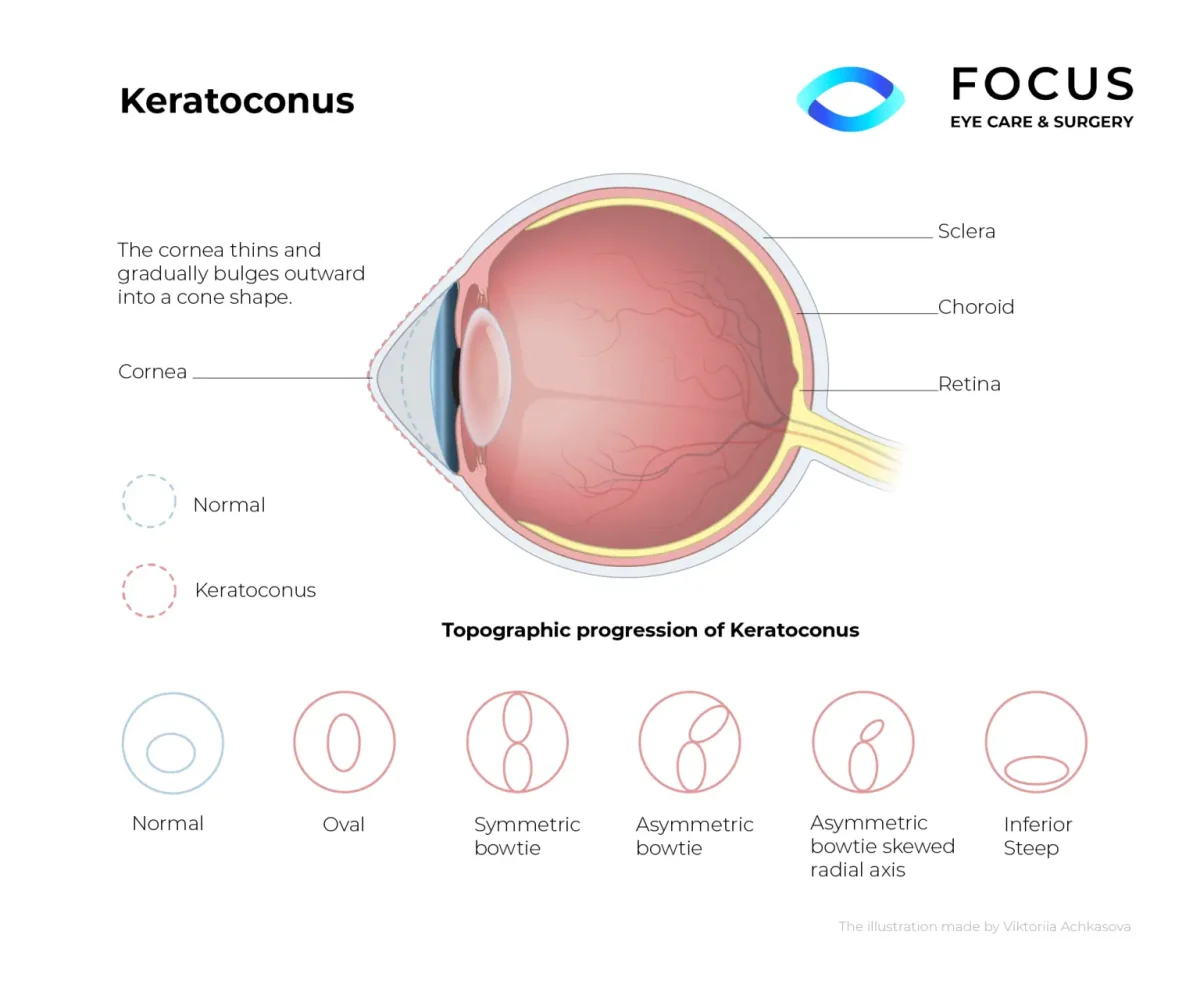
Keratoconus
Keratoconus
What Is Keratoconus?
Keratoconus is an eye disease caused by the cornea’s abnormal shape.
The cornea is smooth and shaped like a dome in a normal eye. This allows light to be bent correctly and focused sharply through the lens onto the retina.
The retina is the light-sensitive layer at the back of the eyes. Light rays are converted into electrical signals in the retina, which are then sent to the brain via the optic nerve. This is how images are formed.
In keratoconus, the cornea bulges forward like a cone. Because the cornea does most of the eyes’ light-bending work, this deformity results to myopia (nearsightedness) and astigmatism (blurred vision at any distance).
Our cornea specialist performs a thorough evaluation for accurate diagnosis and a personalized treatment plan best suited to your needs.



Are Your Eyeglasses Or Contact Lenses No Longer Effective In Correcting The Symptoms Of Keratoconus?
There’s a reason why eye doctors always tell patients not to rub their eyes. It appears that excessive rubbing may lead to deformation of the cornea, the clear surface at the front of the eyes. When the cornea’s shaped is distorted, so are the images you see.
Focus Eye Care & Surgery offers one of the most effective keratoconus treatments New York has available. Dr. Neelofar Ghaznawi is a board-certified cornea specialist performing medical and surgical treatments for keratoconus and other diseases of the cornea. Schedule a consultation with us today to find out if you qualify.
What Are the Treatment Options for Keratoconus?
While there’s no known cure for keratoconus at present, symptoms can be managed such that a person with the condition can still enjoy a high quality of life.
Prescription spectacles
When keratoconus symptoms are mild, glasses and contact lenses may help correct myopia and astigmatism.
Corneal cross-linking
As the disease advances, corrective eyeglasses and contact lenses may no longer be adequate. The cornea may need to be reshaped.
Corneal cross-linking entails the use of laser pulses and liquid riboflavin (vitamin B2) to encourage the growth of new cross-links beneath the cornea to strengthen its support structure and to make it less steep.
Corneal transplant surgery
Transplant surgery involves putting the donor cornea in place of the diseased cornea. Depending on the severity of your keratoconus, the transplant may involve just the front and middle layers of the cornea (partial thickness) or the entire cornea itself (full thickness).
The chances of the body rejecting the donor cornea are lower in partial thickness surgery, and the healing period is also shorter.
Limited studies report that cornea transplant surgeries in the treatment of keratoconus have high success rates (almost 70%) seven years after the procedure.
At Focus Eye Care & Surgery, our New York cornea surgeon specializes in the surgical treatment of keratoconus such as corneal cross-linking, partial thickness transplantation, and full thickness transplantation.
How Do You Get Keratoconus?
Eye doctors are not sure what causes keratoconus, but it appears to be hereditary. Allergic conditions like eczema and asthma also appear to be risk factors.
As the cornea is the eyes’ first layer of contact with the external environment, excessive rubbing of the eyes or incorrectly fitted contact lenses have also been shown to be contributing factors.
Because of its unknown etiology (the study of what causes diseases), keratoconus has no cure at present.

FAQs About Keratoconus
Keratoconus gets worse over time. Early in its development, the condition presents as: blurred vision, sensitivity to light, images appearing ghost-like.
Eye doctors are not sure what causes keratoconus, but it appears to be hereditary. Allergic conditions like eczema and asthma also appear to be risk factors.
As the cornea is the eyes’ first layer of contact with the external environment, excessive rubbing of the eyes or incorrectly fitted contact lenses have also been shown to be contributing factors.
Because of its unknown etiology (the study of what causes diseases), keratoconus has no cure at present.
Yes. One eye may be more severely affected by keratoconus than the other.
Left untreated, keratoconus may cause progressive visual impairment; however, it does not cause total loss of vision. Current treatments allow people with keratoconus to live normal lives.
Keratoconus is not a curable condition, but there are several treatment options to prevent it from further worsening vision. For the early stages of keratoconus, glasses and scleral contact lenses can be used to treat astigmatism and nearsightedness. As keratoconus progresses, corneal collagen cross-linking can be tried to restore corneal strength and prevent worsening of vision. In advanced stages, a corneal transplant may be necessary to restore vision.
The underlying cause of keratoconus is not yet known, but experts believe that there is a genetic component to it. Studies have shown that keratoconus patients have low collagen in their cornea, which may be a result of an imbalance between the destruction and production of corneal tissues. Keratoconus has also been associated with excessive eye rubbing, allergic reactions, and connective tissue disorders.
Keratoconus will not progress to total blindness. However, keratoconus can lead to severe visual impairment if not treated. This visual impairment resulting from advanced keratoconus can be severe enough to be considered a disability.
With increasing age, keratoconus may worsen over time as the cornea can undergo further structural changes. Keratoconus usually affects both eyes, but sometimes it can get worse in one eye more than the other. Certain activities such as eye rubbing and frequent allergies can increase the likelihood of keratoconus to worsen over time.
The safest way to treat keratoconus is to treat it early on to prevent it from progressing further. Early-stage keratoconus treatment options such as glasses and contact lenses are completely safe. Corneal collagen-crosslinking is also a relatively safe, minimally invasive procedure that can slow keratoconus progression by restoring corneal strength.
Although keratoconus itself is not a disability, it can result in visual impairment to such a severe extent that it can be considered to be a disability.
You can perform most physical activities such as jogging and other exercises normally with keratoconus. In fact, some studies indicate that aerobic exercise may help slow the progression of keratoconus. As advanced stage keratoconus is associated with severe visual impairment, any activities such as driving that can endanger the life of the patient and other people should not be performed.
No, keratoconus cannot be cured completely. The best way to treat keratoconus is to start treating it as early as possible using various approaches, depending on the severity of keratoconus, such as glasses, contact lenses, or corneal cross-linking to prevent worsening of vision.


Are You a Candidate for
Vision Correction?
Whether you just need a general eye exam, or if you are interested in reducing or eliminating your need for glasses or contacts, our team is here to help! Contact us to book an appointment today!
The doctors at Focus Eye Care & Surgery have reviewed and approved this content.
Page Updated:


